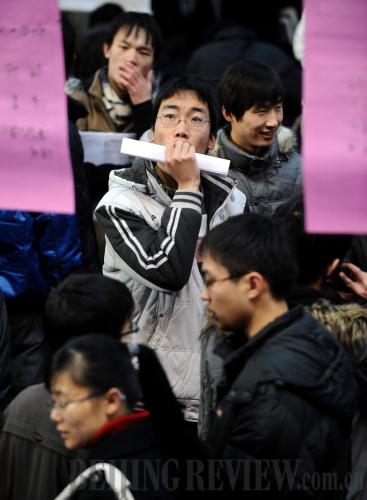|
 |
|
JOB HUNTERS: A surge of fresh graduates swarm into a job fair in Shanxi Province on December 17, 2009, with hopes of securing a job (HU JINGGUO) |
Even amid holiday festivities and feelings of good cheer, the end of the year is traditionally a bad season for job hunters. But each day at the Longgang District labor market, located in Shenzhen in south China's Guangdong Province, more than 600 companies set up stands, offering some 12,000 jobs.
"The number is 20 percent more than it used to be," said Feng Renping, a manager at the Longgang labor market.
Shenzhen was among the first batch of cities opened to the outside world in the 1980s and has since attracted a large number of business elites, professionals and migrant workers. Despite the blow dealt by the sweeping financial crisis to Shenzhen's job market, more people are coming back to work, Feng said.
"Some companies even complain of a shortage of skilled workers," Fend added.
According to figures from the Bureau of Human Resources and Social Security of Shenzhen, on average, one job hunter can choose between two employment options in the local market.
"The stimulus package launched by the Central Government, especially the measures that aimed at stabilizing and expanding jobs, have been carried out in a coherent and effective manner. The overall employment situation is doing well and is better than what had been anticipated," said Yin Weimin, Minister of Human Resources and Social Security, on December 24, 2009.
China's proactive employment policies and measures in response to the financial crisis have yielded positive results, Yin said.
According to Yin, China generated 10.13 million new jobs in urban areas in the first 11 months of 2009, exceeding the government's target of 9 million new jobs for the entire year.
Employment gap
The financial crisis that originated in the United States in late 2008 not only damaged China's economic development but also had a deep impact on the Chinese job market.
Yin said the biggest problem facing the job market is that labor supply far exceeds demand. The crisis has made matters worse—only half of the 24 million job seekers actually found employment in 2009.
The crisis also threw a large number of companies into operational quagmires, resulting in extensive job cuts. The Ministry of Human Resources and Social Security (MOHRSS), after monitoring 513 companies in 15 cities, found that the worst period for layoffs and other employment uncertainties was from October 2008 to March 2009. So far, the registered urban unemployment rate has increased by 4.3 percent, up 0.3 percentage points from the fourth quarter of 2008. The registered urban jobless total surpassed 9 million for the first time after the records began being kept in the 1980s.
The economic growth slowdown has only added to increasing unemployment woes. MOHRSS figures showed in the fourth quarter of 2008—the first three months after the crisis broke out—the number of newly added jobs had declined to 590,000 per month on average, with the worst in December—only 380,000 jobs were created. The figures were far less than the 1.04 million per month prior to the crisis.
| 